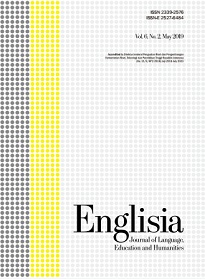RESEARCHING STUDENTS’ ORAL PERFORMANCE: What’s wrong with their use of grammar, vocabulary and pronunciation?
DOI:
https://doi.org/10.22373/ej.v6i2.3485Keywords:
Errors analysis, oral performance errors, causes of errorsAbstract
This study was conducted to investigate errors in oral performance among the third year English Education Department students of UIN Ar-Raniry. It was aimed at two folds of research objectives. First, it sought to investigate the most frequently-committed error of the third year English Education Department students of UINAr-Raniry. Second, it attempted to identify the causes of students’ errors in their oral performance. This study employed qualitative research methods. The participants of this study were 20 students registering in Public Speaking Course. To investigate the students’ errors, a speaking test was used as a research instrument. The test was in the form of individual speaking performance on a topic of “Do we need native speakers in our Tarbiyah Faculty?” The participants were required to speak about the issue, which lasted for 10 minutes each. 20 oral performances were transcribed to enable the analysis of the errors. To analyze the student’s oral performance errors, the content analysis was used. This process was followed by analyzing the different aspects of language: grammar, pronunciation, and categories of error causes in communication. The results revealed that puzzling vowel insertion was the most commonly committed error (316/62.7%) compared to shifts in tense (10/2.0%), word order (19/3.8%), subject verb agreement (14/2.8%), and case of referent (15/3%). These errors were identified to have been caused by interlanguage factor. In an effort to respond to these compelling issues in the students’ speaking performance, lecturers who teach English at the University are required to give their maximum attention in order to improve their students’ oral performance.
Downloads
References
Ainon et al., (2013). Oral presentation errors of Malaysian students in English for academic purposes (EAP) course.World Applied Sciences, 21, 19-27.
Berg, B. L. (2001). Qualitative Research Methods for the Social Sciences. Boston: A Pearson Education Company.
Brown, H, D. (2002). Principles of language learning and Teaching (4th Ed.). New York Longman.
Boothchuy, T. (2008). An analysis of error in Academic English Writing by a group of first year Thai graduates majoring in English. (Thesis, Kasetsart University, Bangkok).
Cohen, L., Manion, L., & Morrison, K. (2007).Research Method in Education. New York: Routledge.
Corder, S. P. (1967).The significance of learners' errors.International Applied Linguistics in Language Teaching, 1(5), 161-167.
Celce-Murcia, M., &Olshtain, E. (2001). Discourse and Context in Language Teaching: A Guide for Language Teachers. Issues in Applied Linguistics, 11(2), 277-279.
Dulay, H., Burt, M., &Krashen, S. (1982).Language Two. New York: Oxford University Press.
Ebrahim, S., &Majid, G. (2011).An account of sources in language learners’ interlanguage.International Conference on Languages, Literatures and Linguistics, 26, 159-182.
Fries, C.C. (1945).Teaching and Learning of English as a Foreign Language. Ann Avbor: University of Michigan Press.
Faerch, C., & Kasper, G. (1983).Plans and Strategies in ForeignLanguage Communication. In Faerch& Kasper (Eds.),Strategies in Interlanguage Communication (pp. 20-60).London: Longman.
Hincks, R. (2003). Pronouncing the Academic Word List: Features of L2 student Oral Presentations Department of Speech, Music and Hearing. ICPhS Barcelona, 5(48), 1545-1548.
Ghadessy, M. (1980).Implications of error analysis for second/foreign language acquisition.Language Teaching.International Review of Applied Linguistics in Language Teaching, 18(2), 93- 104.
Heydari, P., &Bagheri, M, S. (2012). Error analysis: Sources of L2 learners’ error. Theory and Practice in Language Studies, 2(8), 1585-1589.
Hojati, A. (2013). An investigation of Errors in the Oral Performance of Advanced-level Iranian EFL Students.Mediteranian Journal of Social Sciences, 4(4), 171-179.
Jabeen, A., Kazemian, B., &Shabaz, M. (2015).The Role of Error Analysis in Teaching and Learning of second and First Language.Education and Linguistics, 1(2), 52-61.
Keshavarz, M. (2008).Contrastive Analysis and Error Analysis. Tehran: Rahnama Press.
Khansir, A. A. (2012). Error Analysis and Second Language Acquisition: Theory and Practice in Language Studies. Theory and Practice in Language Studies, 2(5), 1027-1032.
Mohideen, H. (1991). Common Mistakes in English: A Guide to Better English in Clear, Simple Language. Toongabbie: PelandukPublicationa Pty. Ltd.
Nemser, W. (1984). Approximative systems of Foreign Language Learners. In Richards, J. L (Ed). Error Analysis, Perspectives on second Language Acquisition (pp. 55-62). Harlow: Longman.
Newmark, L. (1969). How not to interfere with language learning. Language Learning: The Individual and the Process. International Journal of American Linguistics, 40, 77-83.
Phettomkam, H. (2013). Error analysis and its’ implications in communicative English language teaching.THAIJO, 16(3), 97-108.
Rula, D. (2013). University students’ preferences for error correction and teaching and feedback on writing. TESL Reporter, 38(1) 16-34.
Richards, J. L.,&Renandya, W. (2002). Methodology in Language Teaching: An Anthology of Current Practice. USA: Cambridge University Press.
Subramanian, K., &Saadiyah, D. (2009). Error Analysis of written English Essay for Secondary School Students in Malaysia: A Case Study. European Journal of Social Sciences, 8(3), 483-495.
Tarone, E. (2006).Interlanguage.Social Sciences and Humanities, 4, 747-752.
Ting, H, S., Mahdhir, M., & Chang, L, S. (2010). Grammatical Errors in Spoken English of University Students in Oral Communication Course.GEMA Online™ Journal of Language Studies, 10(1), 53-70.
UIN English Lecturer Forum. (2018). Students’ learning progress: Toward underlining barriers in language achievement.
Wei, L. (2011). Communicative Strategies in Second Language Acquisition: A Study of Chinese Learners’ Attitude and Reported Frequency of Communicative Strategies.(1st ed). [ebook] Kristianstad University. Retrieved from www.diva-portal.org/smash/get/diva2:429103/FULLTEXT01.pdf.
Yin, K, R. (2011).Qualitative research from start to finish. New York: The Guilford Press.
Zaghlul, A. (1987). A contrastive analysis of Acehnese and English vowel sounds and its implication in teaching the English vowel sounds to Acehnese learners of English. (Thesis, Kansas State University, Kansas).
Zaki, M. (2015). Implications of contrastive analysis and error analysis in secondlanguage acquisition.Journal in English Language Teaching, 2(1), 1-14.
Downloads
Published
Issue
Section
License
Proposed Policy for Journals That Offer Open Access
Authors who publish with Englisia journal agree to the following terms:
- Authors retain copyright and grant the journal right of first publication with the work simultaneously licensed under a Creative Commons Attribution License that allows others to share the work with an acknowledgement of the work's authorship and initial publication in this journal.
- Authors are able to enter into separate, additional contractual arrangements for the non-exclusive distribution of the journal's published version of the work (e.g., post it to an institutional repository or publish it in a book), with an acknowledgement of its initial publication in this journal.
- Authors are permitted and encouraged to post their work online (e.g., in institutional repositories or on their website) prior to and during the submission process, as it can lead to productive exchanges, as well as earlier and greater citation of published work (See The Effect of Open Access).









